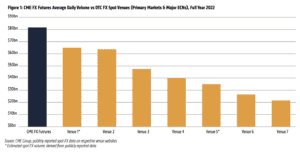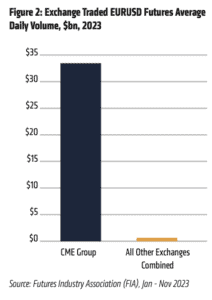CME FX futures and options have seen significant growth in both volumes and participation over the last few years. In 2023, on average over $80 billion of FX futures and options traded every day, with a total of more than $41 trillion notional centrally cleared across 39 currency pairs and more than 95,000 individual traders involved in the ecosystem.
The benefits of centrally cleared futures in FX are increasingly being recognised. Drivers include margin efficiencies relative to non-cleared derivatives for buy-side firms caught by Uncleared Margin Rules, and capital efficiencies for banks under SA-CCR.
However, a common misconception that arises from discussions with clients surrounds liquidity, with many believing that FX futures are not liquid enough for them to transact and that over the counter (OTC) venues remain “better”. While there is clearly a role for both futures and OTC venues in liquidity provision, it is useful to place the CME FX futures market within the context of the leading OTC FX venues, using traded volume as a proxy for liquidity.
Figure 1 compares CME FX futures daily volume with spot FX volumes on the leading OTC venues – the primary markets plus major ECNs. This chart illustrates that although OTC volumes are higher than futures in aggregate, CME FX ranks as one of the top individual venues by volume across the whole FX landscape. This is reinforced further by a recent BIS working paper, which found that “a growing number of market participants of all types now seem to consider currency futures traded on the CME as at least a close cousin of the primary [spot FX] CLOBs.”
Furthermore, trading volume in CME FX futures “now often exceeds OTC FX spot trading volume in the primary market” leading some to argue that “[CME] FX futures do, in some cases, lead price discovery in FX spot.” Having considered OTC markets, it is also instructive to place CME FX in the context of the exchange traded FX futures market. Figure 2 shows the average daily volume for exchange traded EUR/USD futures globally, highlighting that CME Group is the natural home for trading FX futures in major currency pairs. Liquidity means more than just volume though. Topics including reject rates, market impact, the ability to trade passively, and diversity of the trading ecosystem are also hugely important. The majority of CME FX futures are traded on the CLOB. Pricing on the CLOB is firm, anonymous, credit agnostic and all-to-all, with a hugely diverse ecosystem of users.
Liquidity means more than just volume though. Topics including reject rates, market impact, the ability to trade passively, and diversity of the trading ecosystem are also hugely important. The majority of CME FX futures are traded on the CLOB. Pricing on the CLOB is firm, anonymous, credit agnostic and all-to-all, with a hugely diverse ecosystem of users.
This not only means there are zero reject rates, but also enables all participants to be liquidity providers and to trade passively within the order book – reducing transaction costs by avoiding paying away the bid/offer spread. For example, in 2023, 62.8% of hedge fund and asset manager volume was traded passively in FX futures, while for options the proportion was 69.6%.
While the CLOB is the central venue for futures liquidity, some customers want to trade risk-transfer OTC-style via disclosed bilateral negotiations with chosen liquidity providers. This trading style can be particularly important for larger sized trades and for more esoteric pairs that are not as actively quoted in the order book, where liquidity providers can lean on OTC liquidity.
Over the course of 2022 and 2023, there was a sizeable upswing in customers trading CME FX products via these ‘blocks’ (large risk transfer trades) and ‘EFRPs’ (OTC vs. futures spreads), with growth of 67% over that two-year period versus 2021. More than 20 liquidity providers now support these trade types at CME FX, including the majority of top-tier global banks as well as non-bank market making specialists.  “Many customers have long recognised the unique liquidity and clear benefits of using CME FX futures and options as a complement to their OTC activity,” says Paul Houston, global head of FX products at CME Group.
“Many customers have long recognised the unique liquidity and clear benefits of using CME FX futures and options as a complement to their OTC activity,” says Paul Houston, global head of FX products at CME Group.
“However, an increasing number of new participants, particularly from the hedge fund and asset manager community, are looking to access futures to solve margin and capital challenges, whilst also benefiting from the robust liquidity available in our central limit order book combined with the ability to trade on an OTC style basis with 20+ liquidity providers.”
To find out more on how and why traders are using CME FX products please contact FXteam@cmegroup.com.
CME Group futures are not suitable for all investors and involve the risk of loss. Full disclaimer: https://www.cmegroup.com/disclaimer.html. Copyright © 2024 CME Group Inc.
